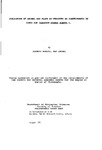EVALUATION OF ANIMAL AND PLANT BY-PRODUCTS AS CONSTITUENTS IN DIETS FOR SEABREAM SPARUS AURATA L.
| dc.contributor.author | NENGAS, IOANNIS | |
| dc.contributor.other | School of Biological and Marine Sciences | en_US |
| dc.date.accessioned | 2013-10-28T11:02:06Z | |
| dc.date.available | 2013-10-28T11:02:06Z | |
| dc.date.issued | 1991 | |
| dc.identifier | NOT AVAILABLE | en_US |
| dc.identifier.uri | http://hdl.handle.net/10026.1/2406 | |
| dc.description.abstract |
The principle aim of the study was to evaluate the nutritional value of animal and plant by-products, with the objective of improving the cost effectiveness of diets for culturing seabream (Sparus aurata). The programme of work was initially directed towards applying the current methodology used in fish nutrition research to establish reliable digestibility coefficients for various feed ingredients. A selection of animal and plant materials were tested for digestibility within a reference basal diet designed for seabream. Ingredients for special consideration included poultry by-product meal, feather meal, meat and bone meal, solvent extracted and full fat soyabean meal as well as various other plant derived mater1als. Comparative values for protein, energy and lipid digestibility coefficients were assessed. On the basis of these measurements, experiments were undertaken to evaluate the optimum inclusion levels of promising protein and energy sources as a replacement for the fishmeal component in diets for seabream. Emphasis was made on recent advances in feed processing technology. Raw materials were evaluated in terms of proximate analysis, amino acid profiles and the degree of heat treatment effects on protein quality and availability. Several indices relating to these included lysine availabil1ty, cresol red values and trypsin inhibitor levels for soya products. Growth performance and feed utilization trials were conducted mainly on juvenile fish in recirculation systems under controlled conditions of temperature and salinity. Nutritional parameters such as specific growth rate (SGR), feed efficiency ~FE) and protein utilization parameters were determined 1n each successive trial. The results were favourable with respect to the partial inclusion of animal products in seabream diets. Poultry byproduct meals proved encouraging even at high inclusion levels. The growth performance of fish fed soyabean meal and full fat soya were initially favourable and merited further consideration. These preliminary trials led to a series of practical diet formulations to contain multi-in9redient components, which confirmed previous findings. Var1able results, however, were reported for full fat soyabean meal in this experiment. Finally, the programme of research was presented in the context of the rapidly expanding mariculture industries of southern Europe w1th a particular relevance to Greece. | en_US |
| dc.description.sponsorship | National Marine Research Centre, Athens | en_US |
| dc.language.iso | en | en_US |
| dc.publisher | University of Plymouth | en_US |
| dc.title | EVALUATION OF ANIMAL AND PLANT BY-PRODUCTS AS CONSTITUENTS IN DIETS FOR SEABREAM SPARUS AURATA L. | en_US |
| dc.type | Thesis | |
| dc.identifier.doi | http://dx.doi.org/10.24382/3423 | |
| dc.identifier.doi | http://dx.doi.org/10.24382/3423 |
Files in this item
This item appears in the following Collection(s)
-
01 Research Theses Main Collection
Research Theses Main


